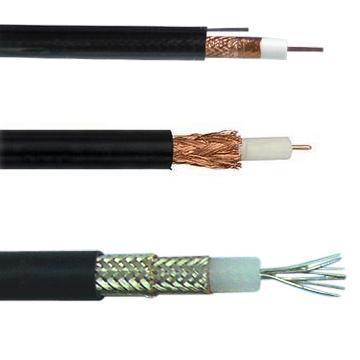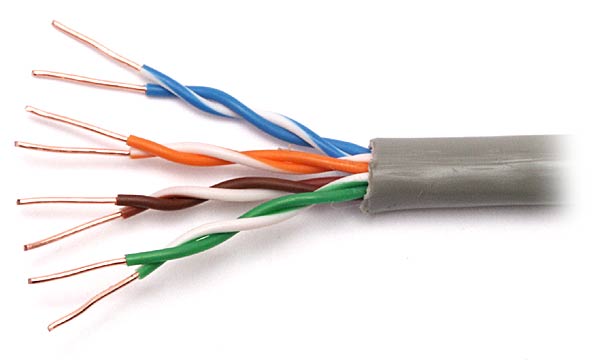TRANSMISSION MEDIA :
The means through which data is transformed from one place to another is called transmission or communication media. There are two categories of transmission media used in computer communications.
- BOUNDED/GUIDED MEDIA
- UNBOUNDED/UNGUIDED MEDIA
1. BOUNDED MEDIA:
Bounded media are the physical links through which signals are confined to narrow path. These are also called guide media. Bounded media are made up o a external conductor (Usually Copper) bounded by jacket material. Bounded media are great for LABS because they offer high speed, good security and low cast. However, some time they cannot be used due distance communication. Three common types of bounded media are used of the data transmission. These are
- Coaxial Cable
- Twisted Pairs Cable
- Fiber Optics Cable
COAXIAL CABLE:

Coaxial cable is very common & widely used commutation media. For example TV wire is usually coaxial.
Coaxial cable gets its name because it contains two conductors that are parallel to each other. The center conductor in the cable is usually copper. The copper can be either a solid wire or stranded martial.
Outside this central Conductor is a non-conductive material. It is usually white, plastic material used to separate the inner Conductor form the outer Conductor. The other Conductor is a fine mesh made from Copper. It is used to help shield the cable form EMI.
Outside the copper mesh is the final protective cover. (as shown in Fig)
The actual data travels through the center conductor in the cable. EMI interference is caught by outer copper mesh. There are different types of coaxial cable vary by gauge & impedance.
Gauge is the measure of the cable thickness. It is measured by the Radio grade measurement, or RG number. The high the RG number, the thinner the central conductor core, the lower the number the thicker the core.
Twisted Pair Cable- BOUNDED/GUIDED MEDIA
- UNBOUNDED/UNGUIDED MEDIA
1. BOUNDED MEDIA:
Bounded media are the physical links through which signals are confined to narrow path. These are also called guide media. Bounded media are made up o a external conductor (Usually Copper) bounded by jacket material. Bounded media are great for LABS because they offer high speed, good security and low cast. However, some time they cannot be used due distance communication. Three common types of bounded media are used of the data transmission. These are
- Coaxial Cable
- Twisted Pairs Cable
- Fiber Optics Cable
COAXIAL CABLE:

Coaxial cable is very common & widely used commutation media. For example TV wire is usually coaxial.
Coaxial cable gets its name because it contains two conductors that are parallel to each other. The center conductor in the cable is usually copper. The copper can be either a solid wire or stranded martial.
Outside this central Conductor is a non-conductive material. It is usually white, plastic material used to separate the inner Conductor form the outer Conductor. The other Conductor is a fine mesh made from Copper. It is used to help shield the cable form EMI.
Outside the copper mesh is the final protective cover. (as shown in Fig)
The actual data travels through the center conductor in the cable. EMI interference is caught by outer copper mesh. There are different types of coaxial cable vary by gauge & impedance.
Gauge is the measure of the cable thickness. It is measured by the Radio grade measurement, or RG number. The high the RG number, the thinner the central conductor core, the lower the number the thicker the core.

The most popular network cabling is Twisted pair. It is light weight, easy to install, inexpensive and support many different types of network. It also supports the speed of 100 mps.Twisted pair cabling is made of pairs of solid or stranded copper twisted along each other. The twists are done to reduce vulnerably to EMI and cross talk. The number of pairs in the cable depends on the type. The copper core is usually 22-AWG or 24-AWG, as measured on the American wire gauge standard. There are two types of twisted pairs cabling
1. Unshielded twisted pair (UTP)
2. Shielded twisted pair (STP)
 Fiber optic cable uses electrical signals to transmit data. It uses light. In fiber optic cable light only moves in one direction for two way communication to take place a second connection must be made between the two devices. It is actually two stands of cable. Each stand is responsible for one direction of communication. A laser at one device sends pulse of light through this cable to other device. These pulses translated into “1’s” and “0’s” at the other end.
Fiber optic cable uses electrical signals to transmit data. It uses light. In fiber optic cable light only moves in one direction for two way communication to take place a second connection must be made between the two devices. It is actually two stands of cable. Each stand is responsible for one direction of communication. A laser at one device sends pulse of light through this cable to other device. These pulses translated into “1’s” and “0’s” at the other end.
In the center of fiber cable is a glass stand or core. The light from the laser moves through this glass to the other device around the internal core is a reflective material known as CLADDING. No light escapes the glass core because of this reflective cladding.
2.Unbound transmission media
Extend beyond the limiting confines of cabling. They provide an excellent Communication Networks alternative for WANS. The lack of physical restrictions provides larger bandwidth as well as wide area capabilities. Unbound media typically operate atvery high frequencies. The three types of unbound transmission media are:
1.Radio wave
2.Micro wave
3.Infrared.
Although Radio waves are prevalent and well understood, we are just beginning to realize their enormous potential as a networking medium. Radio waves can operate on a single or multiple frequency bands.
Microwaves have been used in data communications for a long time. They have a higher frequency than radio waves and therefore can handle larger amounts of data.
Infra Red.



No comments:
Post a Comment